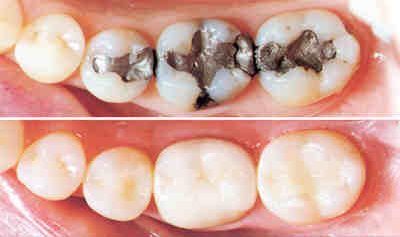.jpg)
Why you may need a filling
You may need a filling to:
- Repair damage caused by tooth decay
- Fix fractures
- Correct surface wear and tear
- Improve surface alignment for better bite and chewing





.jpg)
You may need a filling to:
Fillings can be made from:
Each material has pros and cons associated with it, so you need to discuss the best option for you or your children.

The newer white fillings suit many people. They may be made from porcelain or composite resin and have several advantages:
Aesthetics are the main advantage of composites, since dentists can blend shades to create a color nearly identical to that of the actual tooth. Composites bond to the tooth to support the remaining tooth structure, which helps to prevent breakage and insulate the tooth from excessive temperature changes.
Over time, the shade of the composite can change slightly if the patient drinks tea, coffee, red wine or other staining foods. Composites tend to wear out sooner than silver fillings in larger cavities, although they hold up as well in small cavities. Also, a patient may experience some temporary postoperative sensitivity.
Silver amalgam is the traditional material used for fillings. While it does have some benefits, many people now opt for the more natural looking composite fillings. However amalgam fillings are:
Over the past several years, concerns have been raised about silver-colored fillings, otherwise called amalgams. Because amalgams contain the toxic substance mercury, some people think that amalgams are responsible for causing a number of diseases, including autism, Alzheimer’s disease, and multiple sclerosis.
The American Dental Association (ADA), the FDA, and numerous public health agencies say amalgams are safe, and that any link between mercury-based fillings and disease is unfounded. The causes of autism, Alzheimer’s disease, and multiple sclerosis remain unknown. Additionally, there is no solid, scientific evidence to back up the claim that if a person has amalgam fillings removed, he or she will be cured of these or any other diseases.
As recently as March of 2002, the FDA reconfirmed the safety of amalgams. Although amalgams do contain mercury, when they are mixed with other metals, such as silver, copper, tin, and zinc, they form a stable alloy that dentists have used for more than 100 years to fill and preserve hundreds of millions of decayed teeth. The National Institutes of Health has several large-scale studies currently under way to ultimately answer many of the questions raised about silver-colored amalgams.
In addition, there has been concern over the release of a small amount of mercury vapor from these fillings, but according to the ADA, there is no scientific evidence that this small amount results in adverse health effects.
Different materials will suit different people and situations. Dr St George can advise you and help determine the best solution for your teeth and your circumstances.
“My whole family now visit him. And we know we’re in good hands.”
Find out what's best for you